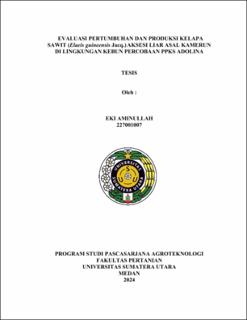Evaluasi Pertumbuhan dan Produksi Kelapa Sawit (Elaeis guineensis Jacq.) Aksesi Liar Asal Kamerun di Lingkungan Kebun Percobaan PPKS Adolina
Evaluation of Growth and Production of Oil Palm (Elaeis guineensis Jacq.) Wild Accessions of Cameroonian Origin in the Environment of PPKS Adolina Experimental Garden

Date
2024Author
Aminullah, Eki
Advisor(s)
Rauf, Abdul
Hanum, Chairani
Metadata
Show full item recordAbstract
Indonesia is one of the world's largest producers of palm oil, producing more than
half of all palm oil globally. Although not indigenous to Indonesia, the sector plays
an important role in the economy, creating jobs and boosting exports. Therefore,
strategic efforts are needed to achieve high and sustainable productivity for the
development of the oil palm industry. One approach that can be applied is through
the introduction of oil palm plants from the region of origin, such as from Cameroon.
The introduction process not only includes the selection of superior varieties that
have characteristics of plant growth and production, but are also able to adapt well
to the surrounding environmental conditions. This study aims to evaluate the growth
of 36 wild accessions of oil palm plants from Cameroon including physical and
environmental aspects and evaluate productivity and its relationship with
environmental factors such as soil, climate and weather. This research was
conducted at the PPKS Adolina Experimental Farm located in Perbaungan District,
Serdang Bedagai Regency, North Sumatra with an altitude of 15 meters above sea
level, soil analysis was carried out at the Research and Technology Laboratory,
Faculty of Agriculture, University of North Sumatra and PT Socfin Indonesia which
began in January to April 2024. The methods used are statistical methods in the form
of non-factorial Randomized Group Design (RAK), ex post facto methods and
descriptive methods. Data from observations of morphological characters were
compiled in the form of descriptive analysis of plants and grouped based on standard
deviation values. To determine the closeness of the relationship between variables,
Pearson Correlation (r) analysis was conducted to obtain the relationship between
climate data with growth and production and between soil data with growth and
production. Each significant data was further tested with multiple linear regression
test using the enter method to see the effect of variable X (climate and soil
characteristics) on Y (growth and production). Observations of morphological
characters include plant height, stem circumference, number of midribs, midrib
length, number of leaflets, leaflet length and leaflet width. Production characters
included bunch weight, number of bunches and average bunch weight. Observations
of soil characteristics include soil texture, soil pH, C-organic, N-total, P-available,
Base Cations, and Cation Exchange Capacity (CEC). The results showed that the
evaluation of the growth of 36 wild accessions of oil palm from Cameroon and the
comparison with the control plant, namely the DxP 540 variety, showed that some
accessions showed good adaptation to the environmental conditions of the Adolina
experimental garden, namely accessions CMR027D, CMR044D, and CMR005D
because they had the character of slower plant height growth and less long fronds and had high production. Evaluation of productivity, it is known that some accessions
are superior, namely accessions CMR097D, CMR044D, CMR025D, CMR055D,
CMR018D, CMR005D, CMR020D, CMR079D because they have the number of
bunches and bunch weight above the average which indicates high productivity
potential. The correlation between growth and production factors of 36 wild oil palm
accessions from Cameroon to environmental factors such as soil, climate and
weather showed a significant effect. Accessions CMR058D, CMR025D and
CMR055D showed many positive correlations with weather conditions, indicating
that these three accessions have good adaptability to environmental changes.
Collections
- Master Theses [429]
